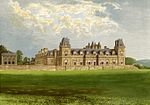Belle Vue Airfield
Airports in DevonDevon geography stubsUse British English from May 2013
Belle Vue Airfield (often classed as airport or heliport) is a single runway airfield about 2.5 miles (4.0 km) north east of Great Torrington in North Devon, England. It is for general and private aviation only, and the 580 meter, or 1,902 foot, runway is grass.It is most popular for model aircraft flying clubs like the Midlands Large Model Aircraft Flying Club to fly their planes at special events here. It is one of the smallest aviation hubs in Devon.It was previously the second hub for Devon Air Ambulance.
Excerpt from the Wikipedia article Belle Vue Airfield (License: CC BY-SA 3.0, Authors).Belle Vue Airfield
B3232, Torridge District
Geographical coordinates (GPS) Address External links Nearby Places Show on map
Geographical coordinates (GPS)
| Latitude | Longitude |
|---|---|
| N 50.977777777778 ° | E -4.0941666666667 ° |
Address
Belle Vue Airstrip
B3232
EX31 3ND Torridge District
England, United Kingdom
Open on Google Maps








